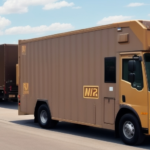What Is the Cost of UPS Shipping?
When it comes to shipping, UPS is one of the most widely used carriers in the United States and around the world. However, understanding the costs associated with their services is crucial before deciding to use UPS for your shipping needs. This guide provides an in-depth analysis of UPS shipping costs, factors that influence these costs, and strategies to save money on your shipments.
Understanding UPS Shipping Services and Pricing
UPS offers a variety of shipping options tailored to different needs, including ground, air, and international shipping. The cost of each service depends on several factors such as package size, weight, destination, and delivery speed. Generally, faster delivery services and larger packages incur higher costs.
Shipping Options
- Ground Shipping: Ideal for domestic shipments with cost-effective delivery times.
- Air Shipping: Suitable for urgent deliveries with faster transit times.
- International Shipping: For shipments to destinations outside the United States, with varying costs based on country and service level.
Value-Added Services
UPS offers additional services such as insurance, signature confirmation, and Saturday delivery, which can increase the overall shipping costs. Choosing the right combination of services ensures that your package arrives safely and meets your specific requirements.
Packaging Options
UPS provides a range of packaging options, including boxes, envelopes, and tubes. Selecting the appropriate packaging helps protect your items and can potentially reduce shipping costs. Additionally, UPS offers packing services for an extra fee, beneficial for shipping fragile or valuable items.
Calculating the Cost of UPS Shipping
To estimate your UPS shipping costs, you can use the UPS shipping calculator. By entering the package weight, dimensions, origin, and destination, you can obtain a cost estimate. Remember that these estimates may vary slightly based on actual shipping conditions.
Factors Influencing the Cost
- Service Type: Different services have varying costs based on speed and delivery features.
- Package Dimensions and Weight: Larger and heavier packages cost more to ship.
- Destination: International shipments and remote areas may incur higher fees.
- Additional Services: Insurance, signature confirmation, and other services add to the total cost.
UPS also offers discounts for frequent shippers and those utilizing their online shipping tools. It's advisable to explore these discounts to reduce your shipping expenses.
Factors Influencing UPS Shipping Costs
Several key factors determine the cost of shipping with UPS:
Package Weight and Size
Larger and heavier packages naturally cost more to ship. It's essential to measure and weigh your packages accurately to ensure you're charged correctly.
Shipping Distance
The distance your package travels affects the cost. Longer distances, especially international shipments, typically result in higher shipping fees.
Shipping Speed
Faster delivery options like next-day or two-day shipping are more expensive than standard ground shipping.
Additional Services and Fees
- Insurance: Protects valuable items but adds to the cost.
- Signature Confirmation: Ensures the package is delivered to the right recipient, increasing the fee.
- Fuel Surcharges: Based on current fuel prices and applied to all shipments.
- Residential Delivery Fees: Additional charges for deliveries to residential addresses.
Customs and Import Taxes
For international shipments, customs regulations and import taxes can significantly impact the total shipping cost. It’s important to research the destination country's regulations to avoid unexpected fees.
Seasonal Demand
During peak seasons like holidays, shipping rates may increase due to high demand. Planning ahead can help mitigate these costs.
Comparing UPS Shipping Rates with Other Carriers
To ensure you're getting the best value, it's essential to compare UPS shipping rates with other carriers such as FedEx and USPS. While UPS may not always be the cheapest, they often provide faster and more reliable delivery services that might justify the additional cost.
FedEx
FedEx is known for its extensive air network and reliable delivery times. It may offer better rates for certain types of packages or destinations.
USPS
The United States Postal Service is typically more cost-effective for small and lightweight packages, especially for domestic shipping.
Choosing the Right Carrier
Consider the specific needs of your shipment, including size, weight, destination, and required delivery speed, when comparing carriers. Using a shipping comparison tool can help identify the most cost-effective option.
Strategies to Save on UPS Shipping Costs
There are several ways to reduce your UPS shipping expenses:
Negotiate Shipping Rates
If you ship large volumes regularly, negotiate lower rates with UPS. Providing details about your shipping volume and needs can help secure discounted rates.
Consolidate Shipments
Combining multiple packages into a single shipment can save on shipping fees. This strategy reduces the number of shipments and takes advantage of bulk shipping discounts.
Utilize Online Shipping Tools
UPS offers various online tools, such as the shipping calculator and package tracking systems, which can help you manage and optimize your shipping processes efficiently.
Take Advantage of Discounts
Look for discounts available to frequent shippers or businesses using UPS's online services. These discounts can significantly reduce your overall shipping costs.
UPS Shipping Fees and Surcharges Explained
UPS applies various fees and surcharges in addition to their base shipping rates. Understanding these additional costs is essential to avoid unexpected expenses.
Fuel Surcharges
This fee fluctuates based on current fuel prices and is applied to all shipments. It is non-negotiable and varies weekly.
Residential Delivery Fees
Additional charges apply when delivering to residential addresses instead of commercial ones. If you frequently ship to residences, consider adjusting your shipping options to mitigate these fees.
Address Correction Fees
If the delivery address requires correction, UPS may charge a fee to update the package information and ensure proper delivery.
Saturday Delivery Fees
Delivering packages on Saturdays incurs extra fees due to the additional labor and operational costs involved.
Customs Clearance Fees
For international shipments, customs clearance fees may apply, covering the processing of your package through customs authorities.
Additional Tips for Effective UPS Shipping
To maximize the efficiency and cost-effectiveness of your UPS shipments, consider the following tips:
Accurate Packaging
Properly packing your items ensures they arrive safely and reduces the risk of damage or delays. Use appropriate packaging materials and follow UPS guidelines for packing.
Labeling Correctly
Ensure that all packages are accurately labeled with the correct address and contact information to prevent delivery issues and additional fees.
Track Your Shipments
Use UPS’s tracking tools to monitor your packages in real-time. This helps you stay informed about the delivery status and anticipate any potential delays.
Plan Ahead
Avoid last-minute shipping to reduce costs associated with expedited services. Planning your shipments allows you to choose more economical shipping options.
Stay Informed on Regulations
Keep abreast of customs regulations and import taxes for international shipments to prevent unexpected costs and ensure smooth delivery.
By understanding the various factors that influence UPS shipping costs and implementing these strategies, you can effectively manage and reduce your shipping expenses while ensuring reliable delivery services.




















